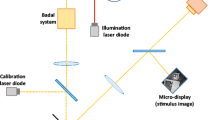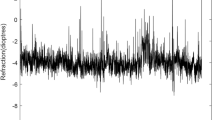Abstract
Three parameters are essential to describe static accommodative behavior in a comprehensive, quantitative manner: the slope of the stimulus/response curve, the depth of focus, and the tonic response. These parameters were obtained in amblyopes, former amblyopes, strabismics without amblyopia, and normals. Results showed that the accommodative response in the amblyopic eye was characterized by a reduction in the slope of the stimulus/response curve and increased depth of focus. Similar abnormalities but of lesser magnitude were found in the non-dominant eye of some former amblyopes and some strabismics without amblyopia. Orthoptic therapy always increased the slope of the stimulus/response curve in the amblyopic eye. We believe that the reduced accommodative responses found in amblyopic eyes reflect a primary sensory loss over the central retinal region that occurs as a result of prolonged, early, abnormal visual experience associated with the presence of strabismus and/or anisometropia.
Similar content being viewed by others
References
Abraham SV (1961) Accommodation in the amblyopic eye. Amer J Ophthal 52:197–200
Alpern M, Mason GL and Jardinico RE (1961) Vergence and accommodation. V. Pupil size changes associated with changes in accommodative vergence. Amer J Ophthal 52:762–767
Badal M (1876) Optomère metrique international: pour la mesure simultanée de la refraction et de l'acuité visulle même chez les elletrès. Ann Oculist (Paris) 57:101–117
Bedell HE and Flom MC (1981) Monocular spatial distortion in strabismus amblyopia. Invest Ophthal Vis Sci 20:263–268
Borish IM (1970) Clinical Refraction, 3rd ed. Chicago, the Professional Press
Bour LJ (1981) The influence of the spatial distribution of a target on the dynamic response and fluctuations of the accommodation of the human eye. Vision Res 21:2187–1296
Bradley A and Freeman R (1981) Contrast sensitivity in anisometropic amblyopia. Invest Ophthal Vis Sci 21:467–476
Brock FW and Givner I (1952) Fixation anomalies in amblyopia. Arch Ophthal 47:775–786
Burian HM and von Noorden GK (1974) Binocular Vision and Ocular Motility. St Louis, Mosby
Campbell FW (1957) The depth of field of the human eye. Optica Acta 4:157–164
Charman WN and Tucker J (1977) Dependence of accommodation response on the spatial frequency spectrum of the observed object. Vision Res 17:129–139
Charman WN and Heron G (1979) Spatial frequency and the dynamics of the accommodation response. Optica Acta 26:217–228
Ciuffreda KJ (1977) Eye movements in amblyopia and strabismus. PhD dissertation, School of Optometry, University of California, Berkeley
Ciuffreda KJ, Kenyon RV and Stark L (1978a) Processing delays in amblyopic eyes: evidence from saccadic latencies. Amer J Optom Physiol Opt 55:187–196
Ciuffreda KJ, Kenyon RV and Stark L (1978b) Increased saccadic latencies in amblyopic eyes. Invest Ophthal Vis Sci 17:697–702
Ciuffreda KJ, Kenyon RV and Stark L (1979a) Fixational eye movements in amblyopia and strabismus. J Amer Optom Ass 50:1251–1258
Ciuffreda KJ, Kenyon RV and Stark L (1979b) Saccadic intrusions in strabismus. Arch Ophthal 97:1673–1679
Ciuffreda KJ, Kenyon RV and Stark L (1980) Increased drift in amblyopic eyes. Brit J Ophthal 64:7–14
Ciuffreda KJ and Kenyon RV (1983) Accommodative vergence and accommodation in normals, amblyopes, and strabismics. In: Vergence Eye Movements: Basic and Clinical Aspects, eds: CM Schor and KJ Ciuffreda. Boston, Butterworth
Ciuffreda KJ, Hokoda SC, Hung GK, Semmlow JL and Selenow A (1983) Static aspects of accommodation in human amblyopia. Amer J Optom Physiol Opt 60:436–449
Ciuffreda KJ and Hokoda SC (in press) Spatial frequency dependence of accommodative responses in amblyopic eyes. Vision Res
Costenbader F, Baier D and McPhail A (1948) Vision in strabismus. Arch Ophthal 40:438–453
Feinberg I (1956) Critical flicker frequency in amblyopia ex anopsia. Amer J Ophthal 42:473–481
Finney DJ (1971) Probit Analysis, 3rd ed. New York, Cambridge University Press
Flom MC, Weymouth FW and Kahneman D (1963) Visual resolution and contour interaction. J Opt Soc Amer 53:1026–1032
Freeman RD and Bradley A (1980) Monocularly deprived humans: nondeprived eye has supernormal vernier acuity. J Neurophysiol 43:1645–1653
Hartinger H (1951) Über ein neues Refraktometer. Ber Dtsch Ophthal Ges 57:105–108
Heath GG (1956) The influence of visual acuity on accommodative responses of the eye. Amer J Optom Arch Amer Acad Optom 33:513–524
Hennessy RT and Leibowitz HW (1971) The effect of a peripheral stimulus on accommodation. Percept Psychophysics 10:129–132
Hess RF and Bradley A (1980) Contrast perception above threshold is only minimally impaired in human amblyopia. Nature 287:463–464
Hess RF, Campbell FW and Greenhalgh T (1978) On the nature of the neural abnormality in human amblyopia: neural aberrations and neural sensitivity loss. Pflügers Arch 377:201–207
Hess RF and Howell ER (1977) The threshold contrast sensitivity function in strabismic amblyopia: evidence for a two-type classification. Vision Res 17:1049–1055
Hokoda SC and Ciuffreda KJ (1982) Measurement of accommodative amplitude in amblyopia. Ophthal Physiol Optics 2:205–212
Hokoda SC and Ciuffreda KJ (1983) Theoretical and clinical importance of proximal vergence and accommodation. In: Vergence Eye Movements: Basic and Clinical Aspects, eds: CM Schor and KJ Ciuffreda. Boston, Butterworth
Hung GK and Semmlow JL (1980) Static behavior of accommodation and vergence: computer simulation of an interactive dual-feedback system. IEEE Trans Biomed Eng BME-27:439–447
Hung GK, Ciuffreda KJ and Semmlow JL (1981) Modeling of human near response disorders. Proc 9th Annual Northeast Biomedical Engineering Conference, Rutgers University, Piscataway, NJ, pp 192–197
Hung GK, Ciuffreda KJ, Semmlow JL and Hokoda SC (in press) Model of static accommodative behavior in human amblyopia. IEEE Trans Biomed Eng
Ittleson WH and Ames A Jr (1950) Accommodation, convergence, and their relation to apparent distance. J Psychol 30:43–60
Kenyon RV, Ciuffreda KJ and Stark L (1980) Dynamic vergence eye movements in strabismus and amblyopia: symmetric vergence. Invest Ophthal Vis Sci 19:60–74
Kirschen DG, Kendall JH and Riesen KS (1981) An evaluation of the accommodative response in amblyopic eyes. Amer J Optom Physiol Opt 58:597–602
Lawwill T (1966) The fixation pattern of the light-adapted and dark adapted amblyopic eye. Amer J Ophthal 61:1416–1419
Lawwill T (1968) Local adaptation in functional amblyopia. Amer J Ophthal 65:903–906
Levi DM and Klein S (1982) Differences in vernier discrimination for gratings between strabismic and anisometropic amblyopes. Invest Ophthal Vis Sci 21:398–407
Mackensen G (1958) Reaktionszeitmessungen bei Amblyopie. Graefes Arch Ophthal 159:636–642
Mann SM (1975) Amblyopia: accommodation as a causative factor. Optom Weekly 67:177
Matteucci P (1960) Strabismic amblyopia. Brit J Ophthal 44:577–582
Morgan MW (1968) Accommodation and vergence. Amer J Optom Arch Amer Acad Optom 45:417–454
Otto J and Graemiger A (1967) Über unzweckmäßige Akkommodation amblyoper Augen mit exzentrischer Fixation. Graefes Arch Ophthal 173:125–140
Otto J and Safra D (1974) Über das Akkommodations verhalten hochgradig amblyoper Augen. Klin Mbl Augenhlk 165:175–179
Otto J and Safra D (1976) Methods and results of quantitative determination of accommodation in amblyopia and strabismus. In: Orthoptics: Past, Present, Future, eds: S Moore, J Mein and L Stockbridge. New York, Stratton
Owens DA (1980) A comparison of accommodative responsiveness and contrast sensitivity for sinusoidal gratings. Vision Res 20:159–167
Owens DA, Mohindra I and Held R (1980) The effectiveness of a retinoscopic beam as an accommodative stimulus. Invest Ophthal Vis Sci 19:942–949
Phillips SR (1974) Ocular Neurological Control Systems: Accommodation and the Near Response Triad. PhD Dissertation, Dept Mech Engn, University of California, Berkeley
Ripps H, Chin NB, Siegel IM and Breinin GM (1962) The effect of pupil size on accommodation, convergence, and the AC/A ratio. Invest Ophthal 1:127–135
Scheiner C (1619) Oculus, Innsbruck
Schor CM and Hallmark W (1978) Slow control of eye position in strabismic amblyopia. Invest Ophthal Vis Sci 17:577–581
Semmlow JL and Tinor T (1978) Accommodative convergence response to off-foveal retinal images. J Opt Soc Amer 68:1497–1501
Sherman A (1970) Some recent clinical observations and training procedures in functionally amblyopic patients. J Amer Optom Ass 49:624–626
Sireteanu R and Fronius M (1981) Nasal-temporal asymmetries in human amblyopia: consequences of long-term interocular suppression. Vision Res 21:1055–1063
Smith W (1950) Clinical Orthoptic Procedure. St Louis, Mosby
Stark L, Bahill AT, Ciuffreda KJ, Kenyon RV and Phillips S (1977) Neuro-optometry: an evolving specialty clinic. Amer J Optom Physiol Opt 54:85–96
Stark L, Ciuffreda KJ and Kenyon RV (1982) Abnormal eye movements in strabismus and amblyopia. In: Functional Basis of Ocular Motility Disorders, eds G Lennerstrand, EL Keller and D Zee. New York, Pergamon Press, pp 71–82
Turner MJ (1958) Observations of the normal subjective amplitude of accommodation. Brit J Physiol Opt 15:70–100
Urist MJ (1959) Primary and secondary deviation in comitant squint. Amer J Ophthal 48:647–656
Whiteside TCD (1957) The Problems of Vision in Flight at High Altitudes. London, Butterworth
Wick B and Grisham JD (1980) Visual therapy for anisometropic amblyopia. Rev Optom 117:37–38
Wold RM (1967) The spectacle amplitude of accommodation of children aged six to ten. Amer J Optom Arch Amer Acad Optom 44:642–664
Wood ICJ and Tomlinson A (1974) The accommodative response in amblyopia. Amer J Optom Physiol Opt 52:243–247
Author information
Authors and Affiliations
Rights and permissions
About this article
Cite this article
Ciuffreda, K.J., Hokoda, S.C., Hung, G.K. et al. Accommodative stimulus/response function in human amblyopia. Doc Ophthalmol 56, 303–326 (1984). https://doi.org/10.1007/BF00155676
Issue Date:
DOI: https://doi.org/10.1007/BF00155676




